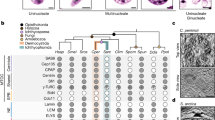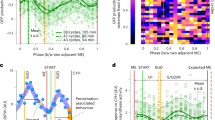Abstract
A model to explain the cell division cycle in both prokaryotes and eukaryotes is presented. No specific ‘G1 functions’ take place during the G1 period, which is merely part of a larger period for the preparation of DNA synthesis which began at the previous initiation of DNA synthesis. A G1 period exists merely because the doubling time of the cells is greater than the sum of the S and G2 periods.
This is a preview of subscription content, access via your institution
Access options
Subscribe to this journal
Receive 51 print issues and online access
$199.00 per year
only $3.90 per issue
Buy this article
- Purchase on Springer Link
- Instant access to full article PDF
Prices may be subject to local taxes which are calculated during checkout
Similar content being viewed by others
References
Helmstetter, C. & Cooper, S. J. molec. Biol. 31, 507–518 (1968).
Cooper, S. & Helmstetter, C. E. J. molec. Biol. 31, 519–540 (1968).
Mendelson, M. L., Dohen, F. C. & Moore, H. A. J. natn. Acad. Cancer Inst. 25, 477–484 (1960).
Sisken, J. E. & Kinosita, R. J. biophys. biochem. Cyt. 9, 509–518 (1961).
Young, R. W. Expl Cell Res. 26, 562–567 (1962).
Defendi, V. & Manson, L. A. Nature 198, 359–361 (1963).
Cameron, I. L. J. Cell Biol. 20, 185–188 (1964).
Cameron, I. L. & Greulich, R. C. J. Cell Biol. 18, 31–40 (1963).
Tobey, R. A., Anderson, E. C. & Petersen, D. F. J. Cell Biol. 35, 53–59 (1967).
Prescott, D. M. Reproduction of Eucaryotic Cells (Academic, New York, 1976).
Helmstetter, C. E. & Pierucci, O. J. molec. Biol. 102, 477–486 (1976).
Robbins, E. & Scharff, M. D. J. Cell Biol. 34, 684–686 (1967).
Liskay, R. M. J. cell. Physiol. 84, 49–56 (1974).
Liskay, R. M. Expl Cell Res. 114, 69–77 (1978).
Liskay, R. M. & Prescott, D. M. Proc. natn. Acad. Sci. U.S.A. 75, 2873–2877 (1978).
Donachie, W. D., Jones, N. C. & Teather, R. in Microbial Differentiation (eds Ashworth, J. M. & Smith, J. E.) 9–44 (Cambridge University Press, 1973).
Mitchison, J. M. The Biology of the Cell Cycle (Cambridge University Press, 1971).
Pardee, A. B., Dubrow, R., Hamlin, J. L. & Kletzien, R. F. A. Rev. Biochem. 47, 715–750 (1978).
Tobey, R. A., Gurley, L. R., Hildebrand, C. E., Ratliff, R. L. & Walters, R. A. in Control of Proliferation in Animal Cells (eds Clarkson, B. & Baserga, R.) 665–679 (Cold Spring Harbor Laboratory, New York, 1974).
Helmstetter, C. E., Cooper, S., Pierucci, O. & Revelas, E. Cold Spring Harb. Symp. quant. Biol. 33, 809–822 (1968).
Author information
Authors and Affiliations
Rights and permissions
About this article
Cite this article
Cooper, S. A unifying model for the G1 period in prokaryotes and eukaryotes. Nature 280, 17–19 (1979). https://doi.org/10.1038/280017a0
Issue Date:
DOI: https://doi.org/10.1038/280017a0
This article is cited by
-
Growth and the cell cycle in green algae dividing by multiple fission
Folia Microbiologica (2019)
-
Chlamydomonas reinhardtii: duration of its cell cycle and phases at growth rates affected by light intensity
Planta (2011)
-
Modeling synchronous growth of bacterial populations in phased cultivation
Bioprocess and Biosystems Engineering (2008)
-
Towards a blueprint of the cell cycle
Oncogene (2001)
Comments
By submitting a comment you agree to abide by our Terms and Community Guidelines. If you find something abusive or that does not comply with our terms or guidelines please flag it as inappropriate.



